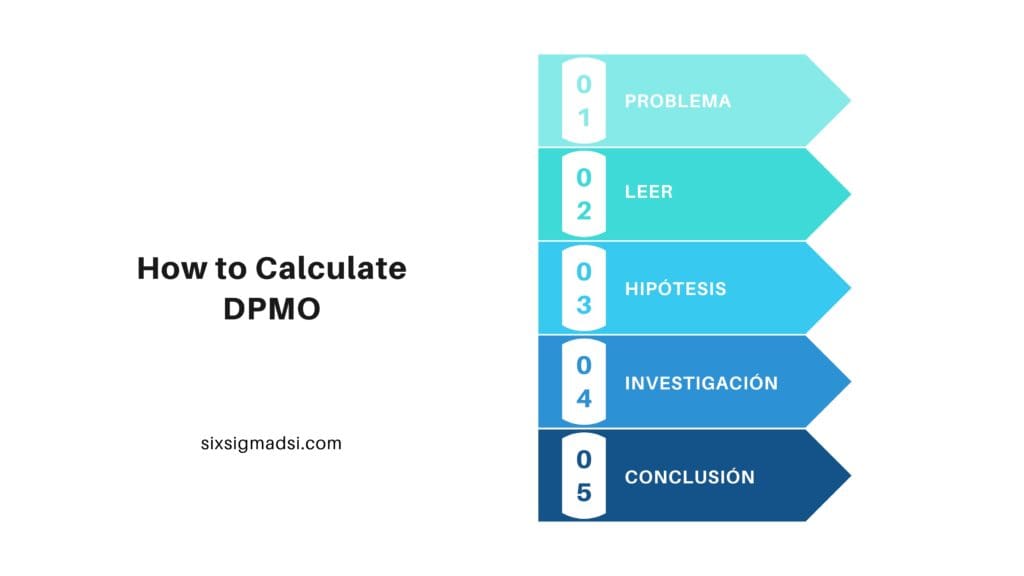Table of contents
What Is DPMO in Six Sigma?
Six Sigma is a set of tools and procedures for improving processes and managing quality. Six Sigma is a business methodology that has become very popular. This method helps in improving the accuracy of processes by using Six Sigma’s Defects Per Million Opportunities (DPMO) level of quality across the value streams. It helps to ensure that operations are efficient and effective. A scientist at Motorola developed it in the 1980s. This technique uses statistical, financial analysis, and project management to improve the qualitative and functional aspects of a company by reviewing errors and defects.
The Six Sigma Method is divided into five phases: Defining (measurement), Analyzing (analysis), Improving (improving), and Controlling. DMAIC can donate it.
- Definition: It involves identifying the problem and defining the goals and deliverables of the project.
- Measurement: Measuring original performance. The team studies the list and determines a benchmark.
- Analysis: The process of analyzing involves isolating the inputs and potential causes for failure, then analyzing them to find the root cause.
- Improving This process involves improving the input or process that does not work well.
- Controlling Measuring outputs after process improvements and ensuring that the results don’t regress, and maintaining the benchmarks set for the process.
What is Lean Six Sigma?
In Lean Six Sigma, a management approach that focuses on team performance in order to eliminate wastes and defects is an approach that focuses on eliminating wastes and defects. Standardization is boosted. This is a combination of Six Sigma tools with Lean enterprise philosophy. It reduces the waste of time, effort, and physical resources while maintaining quality. Learn more about Lean Six Sigma by visiting the Best Six Sigma Certificate Online.
Importance Six Sigma
This method helps in improving the accuracy of processes by using Defects Per Million Opportunities (DPMO) across the value streams. This article will provide more information about this technique.
Many companies hire Six Sigma or Lean Six Sigma professionals to apply their knowledge and improve processes and products. You can become a Six Sigma practitioner by completing six sigma programs and earning certifications. This course will teach you more about the Six Sigma Green Belt Online Certification.

What Does DPMO Stand For?
DPMO in six sigma stands for Defects-Per-Million-Opportunities level of quality. It is a probabilistic measurement of the error rate in a product or business process. It measures the efficiency and effectiveness of a product or process. It measures the likelihood of a product or process making a mistake.
Also known as Nonconformities Per Million Opportunities (NPMO) or Nonconformities.
The DPMO Calculator Formula is:
- It is a measure of long-term process performance that measures the number of defects per million opportunities.
- Learn more about this concept by understanding the terminology.
- I would suggest that we begin with Defects. A defect is a flaw or inconsistency that occurs in a product or process. Multiple defects can be present in a process or an object that causes the client to become dissatisfied.
- A process or object that has one or more defects is considered defective. This means the process or the objective is not acceptable to the client.
- The next step is to identify opportunities. The number of defects in a particular process is called an opportunity. It can be a potential or an actual defect depending on the complexity of a process. As the complexity of a process increases, so do the chances for defects.
Considerations When Using DPMO
There are a few things to keep in mind when using DPMO
- DPMO figures are usually estimates based on stable processes. The numbers will not be accurate if processes are constantly changing.
- You may not have any defects if you don’t expect them. This can lead to inaccurate information. You should use expected DPMO rather than known or observed DPMO to get the most accurate data.
- DPMO is based on opportunities. The metric depends on how many defects there are per unit. It can also depend on what you think your customers will consider a defect. It’s important that you only count what your industry or customers might consider a defect when deciding what counts as a fault.
How Do You Calculate DPMO?
Step 1. Sampling
First, determine how many units will be sampled. The sample group must be both small enough to manage easily and large enough so that it accurately reflects the problem.
Step 2: Defect Opportunity per Unit
The following factors will be considered when determining the number of defects per unit:
- A list of possible defects or errors within a unit or a process.
- Finding the areas where a process or product can go wrong, resulting in a defect.
- Identifying defects that can occur in the normal course of business. It is important not to focus on the exceptions.
- Similarity is a good way to categorize defects.
Step 3: Defect Opportunity for a selected sample size
We need to know the defect possibilities for the selected sample size only.
Multiply the number of defects per unit by the number of units selected in the sample.
Step 5: Calculate the actual defects in the sample group.
This step is to count the number of errors or defects in the selected sample. This process will only be effective if the sample selected is representative of the entire population.
Step 5 – Divide and multiply
Divide the number of actual defects by the number of total opportunities for defects. We get the Defect Per Opportunity.
Then we multiply this result by one million to get the Defect Per Million Opportunity, which reflects long-term health.

What Does the DPMO Value of High-Quality Mean?
DPMO helps in measuring the factors involved in developing a new product or process. It is important to reduce defects in quality after the completion of the product or its delivery.
According to the Six Sigma method, a product’s or process’s quality score must be 3.4 on the DPMO Scale. For a product to be considered of high quality, it must only have a maximum of 3.4 six-sigma defects for every million opportunities.
As the DPMO increases the efficiency of a process or product will decrease and vice versa.
The DPMO values can range from 0 up to 1,000,000. A process with no defects that is efficient will have a value of 0 while a process that is inefficient will be given a value of 1,000,000.
Why Does Six Sigma DPMO Metric Matter?
DPMO level of quality is regarded by organizations using the Six Sigma method as being one of the most significant metrics. The DPMO provides an effective way to measure the efficiency and effectiveness of a product or process in an organization.
This helps to ensure that the final client is satisfied with the service or product, and the highest quality possible.
When determining the DPMO, there are two main values to consider:
- The process to improve should be identified by considering the complexity of both the product and the process.
- The process of establishing the cause-and-effect relationship
Do you have any examples of applied DPMO in Six Sigma?
Leave them in the comments below.



















